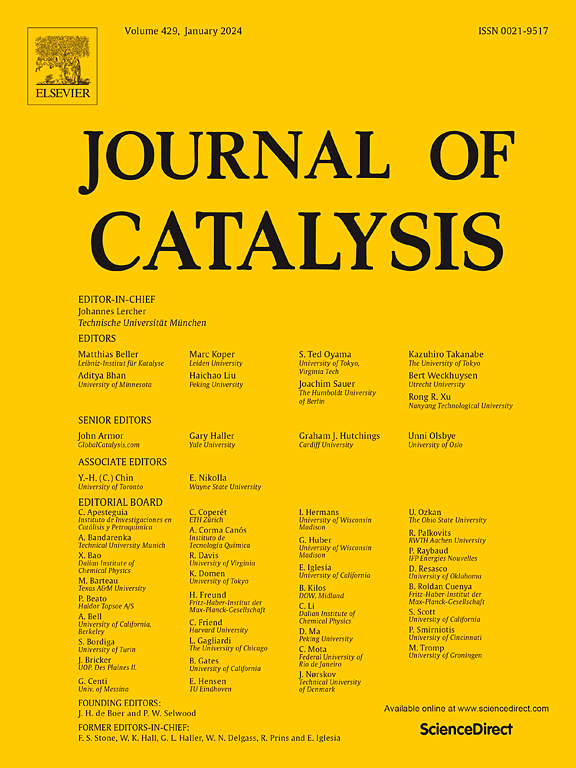Kinetics of hydrogen release from ammonia borane and role of the support for supported Ru catalysts in methanol solvent
IF 6.5
1区 化学
Q2 CHEMISTRY, PHYSICAL
引用次数: 0
Abstract
Ruthenium catalysts are promising for the catalytic release of H2 from ammonia borane (AB). The reaction kinetics and the role of the support in the release of H2 from AB in methanol solvent were studied using a series of Ru nanoparticle catalysts on various supports (SiO2, carbon, γ-Al2O3, and TiO2). Catalysts were synthesized using incipient wetness impregnation and solution deposition (SD) methods and characterized using N2 physisorption, X-ray diffraction, inductively coupled plasma-optical emission spectroscopy, CO diffuse reflectance infrared Fourier transform spectroscopy, and transmission electron microscopy. The reaction kinetics were examined by measuring initial rates using a semi-batch reactor with a constant flow through the headspace analyzed by online mass spectrometry. The Ru/TiO2-SD and Ru/C catalysts had the highest measured initial rates compared to the Ru/SiO2 and Ru/Al2O3. Measured apparent activation energies were relatively similar between all catalysts. Regression of initial rates as a function of AB concentration was done for two different rate equations derived from two different proposed mechanisms for AB methanolysis. Both mechanisms were able to sufficiently describe trends in H2 formation rate versus concentration at low AB concentrations. However, determination of which of the two proposed mechanisms best captures the trends in the data trends was inconclusive due to the lack of a statistically significant difference between degree-of-fit of the two models. Stability tests showed that Ru/C was less prone to deactivation over repeated use compared to Ru supported on the oxides. This study presents a comprehensive examination of the kinetics of AB methanolysis on different supported Ru catalysts; analysis of reaction mechanisms on all catalysts revealed similar apparent first order rate constants from either proposed kinetic models. This study demonstrates that while the support has relatively little influence on the measured reaction rates, carbon may be a preferred support given the decreased deactivation observed relative to the other supports tested.


求助全文
约1分钟内获得全文
求助全文
来源期刊

Journal of Catalysis
工程技术-工程:化工
CiteScore
12.30
自引率
5.50%
发文量
447
审稿时长
31 days
期刊介绍:
The Journal of Catalysis publishes scholarly articles on both heterogeneous and homogeneous catalysis, covering a wide range of chemical transformations. These include various types of catalysis, such as those mediated by photons, plasmons, and electrons. The focus of the studies is to understand the relationship between catalytic function and the underlying chemical properties of surfaces and metal complexes.
The articles in the journal offer innovative concepts and explore the synthesis and kinetics of inorganic solids and homogeneous complexes. Furthermore, they discuss spectroscopic techniques for characterizing catalysts, investigate the interaction of probes and reacting species with catalysts, and employ theoretical methods.
The research presented in the journal should have direct relevance to the field of catalytic processes, addressing either fundamental aspects or applications of catalysis.
 求助内容:
求助内容: 应助结果提醒方式:
应助结果提醒方式:


